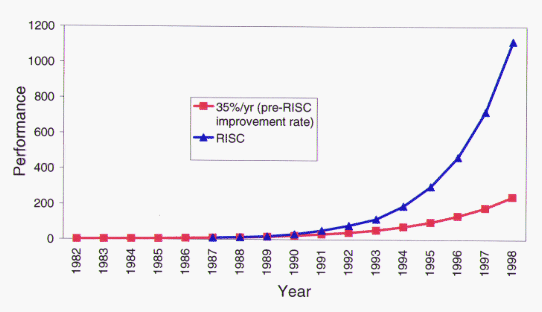
Microprocessor performance over time, relative to the CDC 6600, an early supercomputer

For the first 15 years of its life, the microprocessor improved its performance by an impressive 35% per year. As a result of research at universities and industrial laboratories, though, this rate increased in 1987 to about 55% per year -- a doubling of performance every 18 months! Had the prior rate of 35% been maintained, computers today would be only one third the speed we actually enjoy. Stated differently, it's as if we had been granted a wish to use the computers of the year 2000 in 1995.
This increase coincided with the introduction of Reduced Instruction Set Computers (RISC). The instruction set is the hardware "language" in which the software tells the processor what to do. Surprisingly, reducing the size of the instruction set -- eliminating certain instructions based upon a careful quantitative analysis, and requiring these seldom-used instructions to be emulated in software -- can lead to higher performance, for several reasons:
Begun in the late 1970s, the IBM project was the first to start but was the last to become public. The IBM machine was designed as a minicomputer made from hundreds of chips, while the university projects were both microprocessors. John Cocke is considered to be the father of the 801 design. In recognition of his contribution he received both the Turing award, the highest award in computer science and engineering, and the Presidential Medal of Technology.
In 1980, David A. Patterson and his colleagues at the University of California at Berkeley, sponsored by the Department of Defense Advanced Research Projects Agency, began the project that was to give this approach its name. They built two machines, called RISC-I and RISC-II. Because the IBM project was not widely known or discussed, the role played by the Berkeley group in promoting the RISC approach was critical to the acceptance of the technology.
In 1981, John L. Hennessy and his colleagues at Stanford published a description of the Stanford MIPS machine, also developed under DARPA sponsorship. Both university projects were interested in designing a simple machine that could be built as a microchip within the university environment. All three early RISC machines had similar "reduced" languages.
Importantly, the Berkeley and Stanford projects fit within the broad mosaic of the overall DARPA VLSI Program, a highly ambitious program which envisioned that integrated circuit technology could be made available to system designers -- people with an overall view of the objectives and constraints of an entire hardware/software system -- and that this would have tremendous impact. The DARPA VLSI Program developed the concept of the multichip wafer, which allowed multiple integrated circuit designs to share a single silicon fabrication run, dramatically reducing costs. It conceived of the MOSIS fabrication service, which created a multichip wafer from designs submitted electronically from multiple sites, allowing university system designers access to state-of-the-art silicon fabrication. It sponsored extensive developments in computer-aided design tools. It launched, in addition to the RISC revolution, a comparable revolution in cost-effective high-performance computer graphics through the Geometry Engine and Pixel Planes projects, now the basis of Silicon Graphics, Inc., and Ivex and Division. And it produced people.
In 1986 the computer industry began to announce commercial processors based on the technology explored by the three RISC research projects. Hennessy founded a company with the same name as his research project -- MIPS. Hewlett-Packard converted their existing minicomputer line to RISC architectures. IBM never directly turned the 801 into a product. Instead, the ideas were adopted for a new, low-end architecture that was incorporated in the IBM RT-PC. Alas, this machine was a commercial failure, but subsequent RISC processors in which IBM has been involved (e.g., the Apple/IBM/Motorolo PowerPC) have been highly successful.
In 1987 Sun Microsystems began delivering machines based on the SPARC architecture, a derivative of the Berkeley RISC-II machine. In the view of many, it was Sun's success with RISC-based workstations that convinced the remaining skeptics that RISC was significant commercially. In particular, RISC advocates used Sun's success to get RISC restarted at IBM. IBM announced a new RISC architecture in 1990, as did DEC in 1993. Today, RISC is the foundation of a $15 billion industry.
Intel's microprocessors are used in the popular IBM PC, and hence are the most widely used microprocessors, but they predate RISC. RISC microprocessors have been the standard-bearers of performance, so Intel has embraced ideas from RISC and followed the quantitative approach. Thus both the ideas and the competition from RISC has benefited all computer users, since RISC has raised the performance target for the entire industry. With the announcement that Hewlett-Packard and Intel will move to a common instruction set in 1997, the end of the non-RISC architectures draws near.
Microprocessor performance can continue to double every 18 months beyond the turn of the century. This rate can be sustained by continued research innovation. Significant new ideas will be needed in the next decade to continue the pace; such ideas are being developed by research groups today.
The implications of such a breathtaking advance truly
are limited only by our imaginations.

Microprocessor performance over time, relative to the CDC 6600,
an early supercomputer
Dr. William N. Joy is a founder and currently Vice President for Research at Sun Microsystems, a leading manufacturer of powerful computer workstations. He is currently studying architectures for human-computer interaction, involving new kinds of interfaces, new system and application software architectures, and new ways of storing information to make information systems easier to use.
In the 1970s Joy was the principal designer of the U.C. Berkeley version of the UNIX operating system, whose networking protocols and implementations helped spawn the Internet. (Berkeley UNIX was a DARPA-sponsored effort.) In the 1980s he spearheaded Sun's evangelism of the "open systems" model of computing, which allows different groups to contribute to a computer system by making the specifications of its components freely available. Other technical contributions include co-design of the SPARC microprocessor architecture and several of its implementations, and design of the Network File System (NFS), an industry standard way for computers to share files.
Joy is the recipient of the Grace Murray Hopper Award from the Association for Computing Machinery, and of the Lifetime Achievement Award from the USENIX Association. He has 11 patents issued or pending.